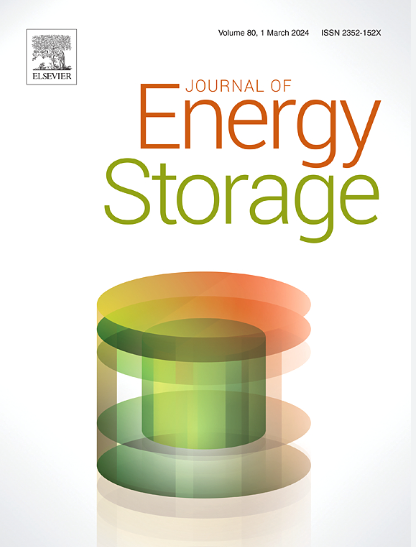Dual carbon-network armored silicon anode: Graphene-CNT reinforced pomegranate architecture enabling long-cycle lithium-ion battery
IF 8.9
2区 工程技术
Q1 ENERGY & FUELS
引用次数: 0
Abstract
Silicon (Si) anode materials have garnered significant attention owing to their exceptional theoretical specific capacity. However, their practical application is hindered by severe volume expansion and particle disintegration. This study introduces a silicon/carbon composite anode material with distinct advantages through rational structural design and straightforward synthesis techniques. A three-dimensional carbon skeleton is developed using the sheet structure of graphene. Specifically, nanosilicon, carbon nanotubes, binders, and graphene nanosheets (GNs) are initially fabricated into spherical composites through spray drying. Subsequently, these graphene-based spheres are encapsulated with pyrolytic carbon via chemical vapour deposition to yield the final product (GBs@SiNPs@CNTs-2). In this composite material, the three-dimensional carbon skeleton, comprising carbon nanotubes and graphene sheets, acts as a conductive matrix and provides buffer space to accommodate the volume changes of silicon nanoparticles during charge and discharge processes. The binder effectively contracts the loose three-dimensional structure during carbonisation and pyrolysis. Additionally, the three-dimensional material particles are coated with a layer of amorphous carbon, which prevents direct contact between the composite Si particles and the electrolyte. Experimental results indicate that the GBs@SiNPs@CNTs-2 composite material achieves an initial coulombic efficiency of 79.2 %, a reversible capacity of 1186.87 mA h g−1, and retains a specific charging capacity of 406.72 mA h g−1 after 500 cycles at 1.0C.
双碳网铠装硅阳极:石墨烯-碳纳米管增强石榴结构实现长周期锂离子电池
硅(Si)负极材料由于其优异的理论比容量而引起了人们的极大关注。然而,它们的实际应用受到严重的体积膨胀和颗粒解体的阻碍。本研究通过合理的结构设计和简单的合成技术,介绍了一种具有明显优势的硅/碳复合负极材料。利用石墨烯的片状结构开发了三维碳骨架。具体来说,纳米硅、碳纳米管、粘合剂和石墨烯纳米片(GNs)最初通过喷雾干燥制成球形复合材料。随后,这些基于石墨烯的球体通过化学气相沉积被热解碳包裹以产生最终产品(GBs@SiNPs@CNTs-2)。在这种复合材料中,由碳纳米管和石墨烯片组成的三维碳骨架充当导电基质,并提供缓冲空间,以适应硅纳米颗粒在充放电过程中的体积变化。粘结剂在炭化和热解过程中有效收缩松散的三维结构。此外,三维材料颗粒被一层非晶碳涂层,这防止了复合硅颗粒与电解质之间的直接接触。实验结果表明,GBs@SiNPs@CNTs-2复合材料的初始库仑效率为79.2%,可逆容量为1186.87 mA h g−1,在1.0℃下循环500次后保持406.72 mA h g−1的比充电容量。
本文章由计算机程序翻译,如有差异,请以英文原文为准。
求助全文
约1分钟内获得全文
求助全文
来源期刊

Journal of energy storage
Energy-Renewable Energy, Sustainability and the Environment
CiteScore
11.80
自引率
24.50%
发文量
2262
审稿时长
69 days
期刊介绍:
Journal of energy storage focusses on all aspects of energy storage, in particular systems integration, electric grid integration, modelling and analysis, novel energy storage technologies, sizing and management strategies, business models for operation of storage systems and energy storage developments worldwide.
 求助内容:
求助内容: 应助结果提醒方式:
应助结果提醒方式:


